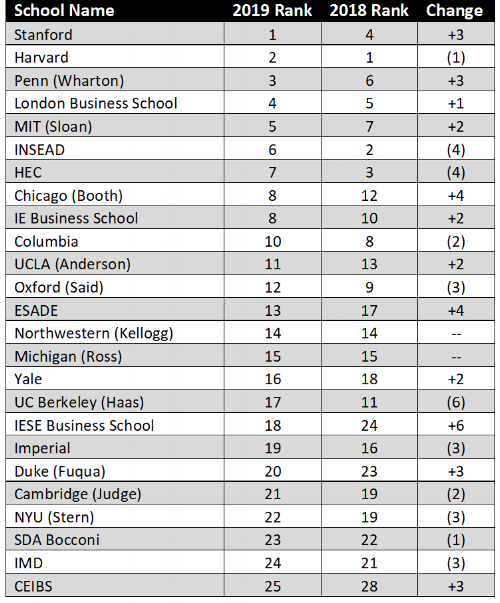The QS Global MBA 2019 Rankings were released this week and Stanford University’s Graduate School of Business ranked first. This is the second year that QS has released global rankings, which include over 250 MBA programs internationally. The ranking’s algorithm incorporates scores for Entrepreneurship & Alumni Outcomes, Return on Investment, Thought Leadership, Employability, and Diversity.
In both 2018 and 2019, 13 of the top 25 programs were based in the US. Also in 2019, four of the top five were based in the US, up from two in 2018. Schools in the US scored particularly well in the areas of Employability and Thought Leadership, while international programs fared better in Diversity and Return on Investment.
There was one new entrant to the top 25, CEIBS, which is based in Shanghai China.
Rankings Indicators
As with all rankings, a closer look at the underlying components, which make up the Overall Score, can provide beneficial information for prospective MBA students. Below are charts showing the top ten ranked schools and their scores for each indicator.
The Entrepreneurship & Alumni Outcomes indicator makes up 15 percent of the overall score. Stanford not only received a perfect score within this indicator but was also about eight percentage points higher than any other program. Harvard, Penn (Wharton), and Michigan (Ross) were also included among the top ten. This indicator should be of particular interest to those keen on pursuing entrepreneurial options post-MBA.
The Return on Investment indicator accounts for 20 percent of the overall score. Programs in the US did not fare as well in this category, though Carnegie Mellon (Tepper) and Michigan (Ross) are included within the top ten. International programs with shorter durations saw the highest scores, as shorter programs save students money, both in terms of tuition, as well as lost wages.
The Thought Leadership indicator makes up 15 percent of the overall score. US schools scored well in this category with MIT (Sloan) receiving a perfect score, followed closely by Penn (Wharton).
The Employability indicator was given the heaviest weight, and accounts for 40 percent of the overall score. The top five programs, four of which are US schools, all received scores of 99 or higher.
The Diversity indicator, which includes Class and Faculty diversity, accounts for ten percent of the overall score. For the second year in a row, no schools from the US were in the top ten in this category. And this is not expected to change significantly in the coming years as international applications to US programs continue to decrease.
Find full results here: https://www.topuniversities.com/university-rankings/mba-rankings/global/2019







